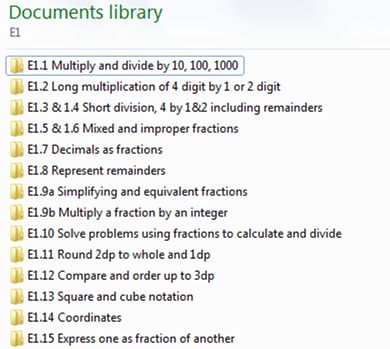I’ve spent a large chunk of my time over the last 18 months writing a scheme of work for Key Stage 3. I wrote a blog in June about our experiences of a year of mastery teaching and it’s a theme I’ll come back to in later posts over the summer, as the endless (M)astery debate is getting a lot of air time at the moment. As a side note, it’s worth reading Charlie Stripp’s blog posts and Andrew Blair’s responses for views from both sides of the table.
I decided that today’s post for the SBPC (Summer Blog Post Challenge – read here) should be about that journey, and the pitfalls I’ve met along the way. For a much more in-depth chronicle of writing a scheme, I suggest checking out Craig Barton’s 19 part series – it takes a while to read, but has some great tips and ideas if you’re in the same position I was a few months ago.
Step 1 – Assess starting point
This was really easy for me – our starting point was nearly nothing. For a bit of context, the department had been using the New Maths Frameworking books for quite a while, and the scheme was pretty much “follow the textbooks”, with a bit of supplementary NRich material thrown in. The assessments weren’t really working for the pupils, and many of them felt that we were moving on far too quickly and nothing was sticking – evidenced by the fact that pupils were sometimes scoring 3 or 4 out of 50 on the half-termly tests, despite having superficially “got it” after one lesson.
However, even when starting a scheme from scratch, I was wary of throwing out the baby with the bathwater. We already had a good deal of stuff that worked, and I wanted to keep that in our new scheme.
Step 2A – Plan an approach
One of the fundamental things to change in our new scheme was the amount of time spent on topics. I started to think about the way I teach GCSE, which is to pick up a strand and follow that – for example, I usually teach linear sequences, followed by graphs, then into solving equations, which helps pupils to build the links between topics.
I started writing a thematic curriculum along these lines, with the idea that each year group would follow a certain “theme” each turn. So, for example, the Year 7 themes were:
- Looking for patterns – Sequences, basic algebra, graphs, substitution
- Planning a Christmas party – Written and mental calculations, ratio, rounding, measurements
- The power of 10 – Place value, metric and imperial (because they were still in the curriculum then), multiplying and dividing by powers of 10.
- The farmer’s field – Perimeter and area of squares, rectangles and composite shapes, mental calculation methods, unit conversion.
- The average Year 7 – Basic data handling cycle.
- Maths and Art – Shape and angle properties, transformations, 2D and 3D shapes.
I then broke it down further into single objectives for that unit – so the first unit in Year 7 consisted of:
Skills
- Generate sequences from term-to-term or nth term rule.
- Find nth term of a sequence.
- Recognise arithmetic/geometric sequences.
- Conventional notation for priority of operations, including brackets and powers.
- (Informally) Use integer powers and associated real roots.
- Use algebraic notation; understand that algebraic notation follows same convention (order of operations).
- Understand concept of expressions, equations, terms.
- Substitute into algebraic formulae.
- Work with coordinates.
- Graphs of linear functions.
- Interpret relationships algebraically and graphically.
- Calculate gradients and y-intercepts graphically.
- Link in ratio notation and discussion of proportion.
- Direct proportion and linear relationships.
Exploration
- Mobile phone tariffs.
- Speed, distance, time relationships.
- Important sequences e.g. square numbers, cube numbers, Fibonacci.
- Fermat’s Last Theorem.
- Happy Numbers.
I’ll add now that this isn’t what we ended up doing, for reasons detailed below. With a year of mastery teaching behind me, I’m now looking back and wondering if even that list of things is a little ambitious for some Year 7s to achieve in a half term, particularly those who can’t accurately multiply and divide.
I’d still like to make a thematic curriculum work, as I think it would be quite enjoyable to teach. Unfortunately, I just don’t have the time to reinvestigate at the moment, particularly with all the changes we’re adapting to across the board.
Step 2B – Throw it all out and start again
Writing a thematic scheme for five year groups over the summer last year may well have killed me. Fortunately, before I’d gone too far down that route, my HoD came back from a meeting with the bare bones of Trinity’s Mastery Pathway. At this stage in its development, there was little more than a rough outline of objectives and a baseline assessment, so it would still take a lot of work. You can read about the basic ideas behind it here.
We decided to take this on for three reasons:
- It agreed with a lot of our aims about teaching less content more slowly – this is what mastery is in my head, and this was a few months before it became the contentious buzzword it is now.
- It sorted out our issues with assessing without levels.
- The chunking of topics was similar to the thematic bits that I’d written, but the order was more sensible – for example, starting off with basic number skills if pupils haven’t already mastered those. It’s difficult to teach algebraic fluency if numerical fluency isn’t already there.
Step 3 – Resourcing the scheme
Because (at that stage) we had very little to go on, and schemes of work were being written over the course of the year, I decided that I’d need to do a lot of work on the bare bones to turn it into something that the department could use.
The first thing I did was collate all of the existing resources and categorise them by study step. Both the resources on our school system and my resources were in an absolute mess, with things randomly saved everywhere. Although this was probably the most time-consuming part of the project, it’s saved me countless hours over the course of this year, because I can just click on the step I’m currently teaching and find all the resources I’ve got saved.
I’m hoping to get a similar system up and running properly on my site this year to make it easier to share resources with other schools working on the Mastery Pathway.

Step 4 – Writing the flippin’ stuff
Once I’d got all the resources in place, I started trying to put together a working document to serve as our scheme. I was unsure how to make this work – I started with a document with several columns for each objective and began hyperlinking resources. This quickly got very unwieldy, as I wanted to include a description of each resource as I put it in.
I then decided to move away from having one document to writing a scheme, then objective plans. I’ll talk more about why this hasn’t worked in the next bit…The issue of time planning was further complicated by the fact that we have many split classes in Key Stage 3, so I had to try and split topics between teachers – so for example, one teacher would deliver the number content for that step, while the other delivered the algebra or shape. This didn’t work either…
I’ll add that doing both of these things took absolutely forever, and I really don’t recommend it.
It’s not all doom and gloom – the stuff I wrote has been used this year, and we’ve found it useful to be able to navigate quickly to appropriate resources.
Step 5 – Adopt, Adapt and Improve
Over the course of this academic year, I started properly developing the “Resources” section of my site, and found that I was duplicating an awful lot of my efforts. When I found new resources to add, I either wasn’t at school (so unable to access the objective plans easily), or didn’t have the time to muck around hyperlinking and adding a description. It was much easier to just plonk resources in the appropriate step folder, both for myself and for colleagues.
The scheme we have is now working well, but the management and improvement of it is not. It’s too much of a time-sink to keep on top of managing (by a rough count) approximately 200 separate documents and maintaining all the links, particularly when I’m doing a lot of that on my site already!
I’m currently playing around with ideas for how I’ll do this, and try to balance sharing my stuff with everyone, while also keeping our department’s work a priority. There’s another site section in development for all of this, and I’ve already reworked four step plans. There will be lots more blogging along these lines in my blog-post-a-day summer challenge!

